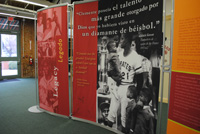Editorial
Front Page - Friday, January 21, 2011
River City Roundabout
We have a dream
Erica Tuggle
 The African American Museum, located in the Bessie Smith Cultural Center on Martin Luther King Blvd., contains items chronicling the history of African Americans in Chattanooga and across the nation, from examples of African art to Barrack Obama’s presidential win. Also within the museum this month is a special exhibit on the life of Roberto Clemente, Pittsburgh Pirates all-star outfielder and the country’s first Latino American hall of famer.
- Erica Tuggle
The African American Museum, located in the Bessie Smith Cultural Center on Martin Luther King Blvd., contains items chronicling the history of African Americans in Chattanooga and across the nation, from examples of African art to Barrack Obama’s presidential win. Also within the museum this month is a special exhibit on the life of Roberto Clemente, Pittsburgh Pirates all-star outfielder and the country’s first Latino American hall of famer.
- Erica Tuggle
Within the Bessie Smith Cultural Center, there is a museum that few people know about, but everyone should visit. It contains a large chunk of Chattanooga’s history that books can’t fully impress and of times when individuals went to amazing lengths to achieve their goals.
The African American Museum is where information and memorabilia, from examples of early African artwork to the newspaper announcement of the election of President Barrack Obama, is housed. This museum provides a tip of the iceberg look at how Chattanoogans were reacting to the events in history that affected the African American race.
There are pictures of colonial African Americans, the first African American schools and famous African Americans in music, entertainment, literature and politics. There is a replica of what an African American home may have looked like in the 1800s.
There is also an area set up with pews and a pulpit, containing relics used in worship such as communion bowls and old hymnals. There is even a road sign denoting how far it is to the Presbyterian and then the distance to the separate Baptist “colored church.” To see the glaring inequalities that the country held to for so long in such a concrete form is something that everyone should see to begin to fully understand the struggle African Americans have gone through to achieve equality.
The pictures of people in the museum are also fascinating, because these old time photographs tell stories of their own. One of these pictures is the seemingly illuminated and smiling face of Lillie B. Speight, the first African American teacher on Lookout Mountain. The Topsy-Turvy Doll at the museum features a doll in the image of a white girl on one end and a black girl on the other. The origins of this doll are unknown, but it is thought that they were made for slave children so that they could hide the fact that they were playing with a doll of their own race by simply turning the doll over and covering the other half with the dress of the upper half of the doll.
Pictures of the first free public African American school in Chattanooga, Howard High School, are also an interesting part of the museum. The school, founded by Rev. E. O. Tade in 1865, has been one of the largest and best equipped high schools in Tennessee. Rev. Tade was active in every part of the African American community and served as county school superintendent. There is also a portion of the museum that features pictures and stories from Bessie Smith’s life as well, and tells of how this Blues Queen rose higher than anyone before her despite the hardships she endured.
Within the museum, there is a traveling Smithsonian Institution exhibit called “Beyond Baseball: The Life of Roberto Clemente.” This exhibit (available through Jan. 30) details the life of this amazing man who was the Pittsburgh Pirates’ all-star outfielder and the first Latino American hall of famer.
Clemente ranks among the best professional baseball players of all time. He earned the most valuable player award, received 12 Gold Glove awards, four national league batting titles, 12 all-star game selections, two World Series championships and reached the 3,000-hit milestone.
The highlight of his career came in 1971, when he earned the World Series MVP Award for his performance in the Fall Classic against the heavily favored Baltimore Orioles. Clemente batted 414, hit two home runs and turned in several standout defensive plays to carry the Pirates to one of the most surprising results in World Series history.
Yet, Clemente’s legacy is also in the work he did outside baseball as a humanitarian and freethinker. Similar to what Jackie Robinson did for African Americans a decade earlier, Clemente did to help blaze the trail for Latino ballplayers.
Clemente addressed the issue of racism openly in the media and demonstrated extraordinary devotion to his community and homeland. His humanitarian work resulted in the founding of “Sports City,” an athletic complex near San Juan, Puerto Rico for disadvantaged youth. Unfortunately, it was still in his efforts to do good for the world that Clemente lost his life in a plane crash while attempting to deliver aid to earthquake victims in Nicaragua.
Visitors can tour this exhibition as well as other exhibits at the Bessie Smith Cultural Center Monday through Friday between 10 a.m. and 5 p.m. and on Saturdays from noon to 4 p.m. General admission is $7 for adults, $5 for senior citizens and students and $3 for children ages six to 12.?
This is a great opportunity to learn more about those who have fought for and shaped the rights that we enjoy today, and this museum provides a nice homage to their efforts and accomplishments.
Contact Erica Tuggle at reporter@hamiltoncountyherald.com.
|
|